The Duomo of Amalfi, situated at the top of a long flight of steps, dominates the city’s main square. During the Middle Ages Amalfi was one of four powerful Maritime Republics of Italy. It traded prolifically with other countries, in particular the Orient and the Maghreb. The monument complex of the Cathedral (Duomo) is a testament to that past. Ascending the steep flight of steps gives the tangible impression of reaching up towards God. At the top of the steps are two bronze doors with a fresco of St. Andrew above that were cast in Constantinople in 1057.
The bronze doors are the main entrance to the Cathedral; however visitors today gain access to the Cathedral complex via a side door leading to the Paradise Cloister. Stepping into the cloister I noticed how peaceful and quiet it was in stark contrast to the hustle and bustle of Amalfi itself. The cloister, Oriental in style, is the ancient cemetery of the nobility of Amalfi. A small Mediterranean garden is situated in the middle of the cloister courtyard and round the edges of it are sarcophagi, marble fragments with decorated mosaics and small funerary chapels. The Cathedral bell tower which is Moorish in style can be seen through the cloister arches.
To one side of the cloister is a door which takes you into the small Corsano family chapel with its fourteenth century frescoes depicting the Death of the Virgin and also Saints and Prophets. The chapel leads to the Basilica of the Crucifix. The Basilica, recently restored back to a single nave, was once dedicated to Our Lady of the Assumption and subsequently to the Saints Cosmas and Damian.
The oldest part of the nave was the first Cathedral of Amalfi, dating to the sixth century AD. The church was extended during the tenth century and when the new cathedral was built adjacent to the original church, the two were connected by a long colonnade, remnants of which can be seen in the southern wall. The styling gives the nave the appearance of a Christian mosque. The nave was altered in the fifteenth century to make way for the Paradise Cloister and construction of small family chapels for wealthy families, a few of which have survived with fourteenth and fifteenth century frescoes.
Since 1996 the Basilica has been home to the Diocesan Museum which displays sacred objects from the treasures of the Cathedral of Amalfi. The collection displays many objects of interest including relics in caskets, silver skull reliquaries, a wooden fragment of Christ’s Cross, a casket containing a Holy Thorn, monstrances, vestments, sculptures, paintings and liturgical items. In the apse of the Basilica hangs a stunning fourteenth century Crucifix.
Steps from the Basilica lead down to the crypt where relics of the body of St. Andrew are kept. St. Andrew was crucified in the Greek city of Patras and his body was taken to Constantinople. Later, during the Fourth Crusade, it was moved to Amalfi by the papal legate Cardinal Pietro Capuano. The relics were placed in the crypt in May 1208.
The current style of the crypt dates to the seventeenth century. Beneath the main altar lies a crystal ampule from which on the vigil of St. Andrew’s Feast Day (and occasionally at other times) a substance called ‘Manna’ is collected. This is a dense liquid which sweats out of the tomb of the Apostle. The event first happened in Patras then in Constantinople and now in Amalfi. Above the altar is a bronze statue of St. Andrew the Apostle which is flanked by a pair of marble statues of St. Stephen and St. Lawrence representing the Western and Eastern churches. Behind the altar are large images of St. John the Baptist and St. Andrew.
The back of St. Andrew’s skull is currently in the Reconciliation Chapel of the Cathedral so that it can be venerated by the faithful.
Steps from the crypt lead up to the cathedral which I found to be rather dark and slightly oppressive. However the guidebook describes it as a wonderful, inspiring spectacle. The current baroque style has obscured most of the original Romanesque structure. The panelled ceiling and canvases adorning the walls depict scenes from St. Andrew’s life. Both the left and right aisles have chapels containing interesting artefacts including a catafalque bearing a sculpture of the dead Christ, which, on Good Friday, is used in a procession along the streets of Amalfi.
NB:
- I have used the guidebook of the The Diocesan Museum of Amalfi as a source of information.
- Other relics of St. Andrew of the Apostle are claimed to be held in St Andrew’s Cathedral, Patras, Greece, St. Mary’s Cathedral in Scotland and perhaps in other locations.

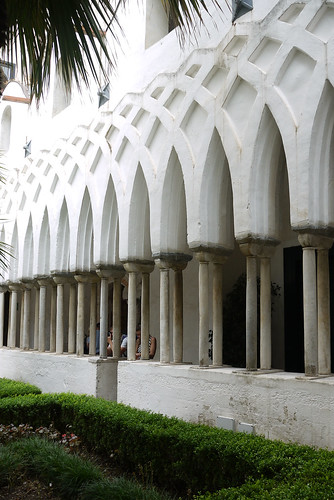
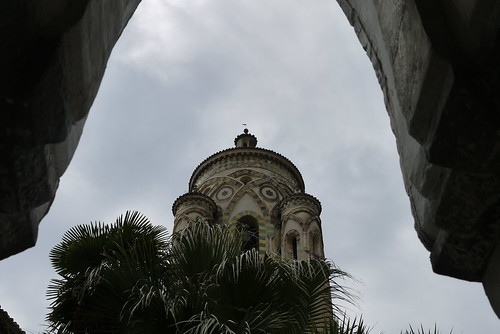
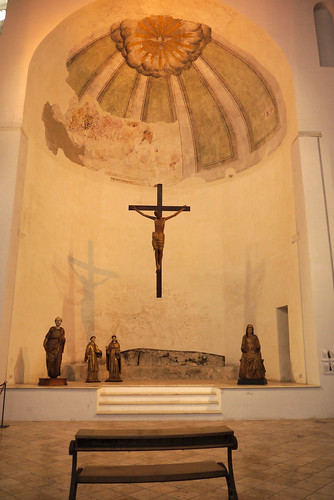
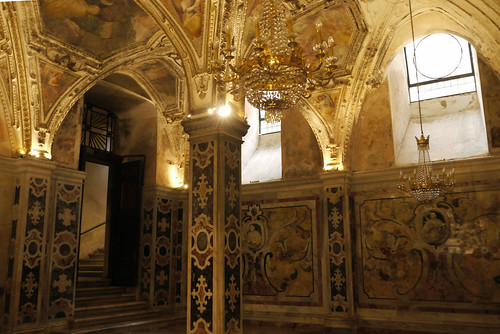
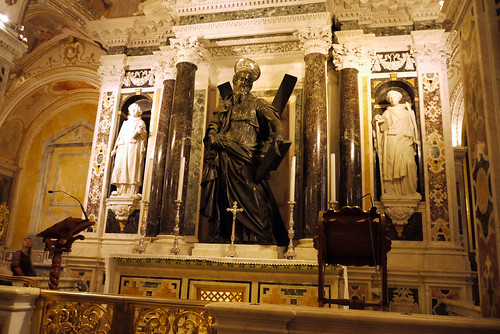
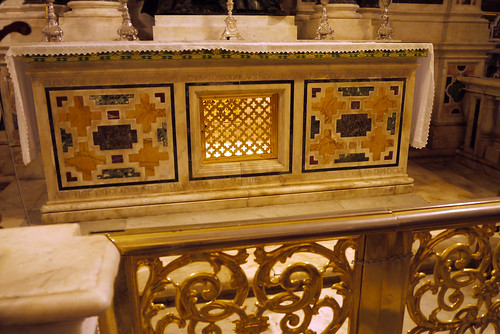
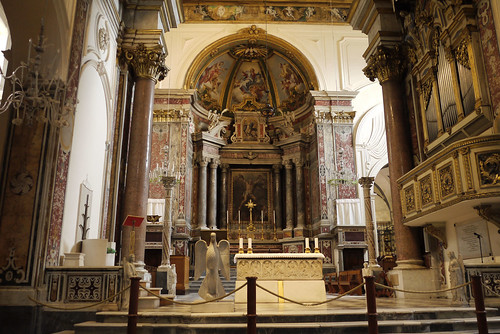
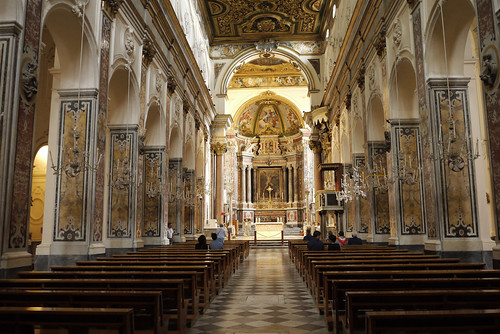









Different world the Catholic world.
Not really. Anglican traditions and faith were always grounded on the same basis as the Catholic faith even as late as the early 1900’s. And yes I do have evidence of this in a small publication of ‘A Catechism of Christian Faith and Practice’, written by Anglican ministers.
Henry VIII chose to break from the Church of Rome because he could not get his own way. Despite that his religious beliefs remained Catholic. Acting as a political head rather than a spiritual head he and his kingly/queenly successors caused untold damage to the established Christian faith.
Those moved by the spirit (rather than politics), Roman and Anglican (both Catholic in their roots) teach what Jesus taught.
In my opinion, the two sources of most classy architecture and decoration were Moorish Spain and the Byzantine Empire. If during the Middle Ages Amalfi was a powerful Italian trading and maritime republic, then it makes sense that the Duomo of Amalfi would be (overly) spectacular. The Cathedral bell tower is perfect. And the bronze doors from Constantinople in 1061 are not fancy but very impressive.
I found that this type of architecture is common throughout the region, including the bronze doorways and interiors. This style was quite new to me, giving me a sense of wonder.
A place to spend a full day in just to see and absorb all the beauty and interest. It is stunning. I am reminded by words to JH that this is a part of our heritage – of western civilisation. I am reminded also of those who decry the ‘wealth’ of the Catholic Church and want it all sold off and the money given to the poor. Hah! Who could buy that Cathedral? Who could buy the 1000+ years of history and devotion: the skill of yesterday’s craftsmen; the care and creativity of the artists and artisans; the prayers of countless hundreds of thousands wo have gathered there to pray for humanity? How much would ’someone’ pay?
You did well showing and explaining. Your work is a prayer in itself.
Thank you I am glad you enjoyed the post.
I am glad you enjoyed the post.
I agree with you that this is the heritage of western civilisation. These old Cathedrals and Churches are full of history, art, beauty and faith all collected over hundreds of years.
Those that say the treasures should be sold off probably don’t realise that the people who worship there will have given their own money to help the poor and other disadvantaged people.
So opulent!
I don’t think we have many Catholic churches in Malaysia.
Quite a few famous Anglican churches though.
St George’s in Georgetown, Penang is one of them.
It’s painted white outside and inside, so it’s rather unusual.
http://www.youtube.com/watch?v=nnmzzxX6Qlc
But them again, most colonial buildings in Malaysia are painted white.
I don’t know why…
White reflects away the hard sunlight in the tropics. It is for cooling.
That is a fine looking church LC
I absolutely love the first picture. That POV on those stairs.
And what a great place to visit. You sure did see some wonderful things in Italy.
Thank you That photo was taken in my iPhone after my camera stopped working.
That photo was taken in my iPhone after my camera stopped working.
You got some great angles in these shots – looking up the stairs and along the side of the building.
I am glad you like them
Wonderful article and photos, CP. Those interiors are so amazingly over the top, but stunning, of course. Certainly somewhere that would be fascinating to visit. I try not to think about the moral angle. Thank you for remembering my piece on St Andrew as patron saint of Scotland and helping with that. Link here, if any of your readers is interested http://bitaboutbritain.com/st-andrew-patron-saint-of-scotland/
I have always found the business of relics a little odd in this day and age – though extremely interesting.
It was well worth a visit as were the other Cathedrals in the area. I am not sure what to think about bits of a body being split up and held in different places. It does however make for interesting research into the history.
Spiritual and absorbing place!!!
Reaching to the God ,what an amazing thought these steps show !
thank you for sharing such outstanding photos and specially the history related to it
Thanks Shabana
I am so happy that my photos convey the feeling of the place to you.